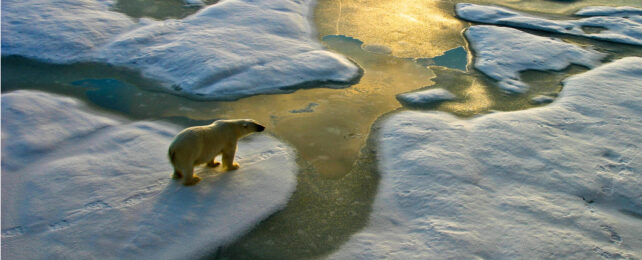A decades-old global environmental pact has averted huge amounts of sea ice loss in the Arctic, new research shows.
Banning ozone-depleting gases under the historic 1987 Montreal Protocol has delayed the first, feared ice-free Arctic summer by as much as 15 years, the study found – once again demonstrating that global treaties can work to huge effect.
"While stopping [sea ice loss] was not the primary goal of the Montreal Protocol, it has been a fantastic by-product," says University of Exeter climate scientist Mark England, who co-authored the study.
Aside from destroying ozone in the atmosphere, the CFCs (chlorofluorocarbons) outlawed under the Montreal Protocol are also heat-trapping gases. Though not as abundant as other greenhouse gases such as carbon dioxide (CO2), studies like this one show CFCs can have a real impact on global warming.
England and Lorenzo Polvani, a geophysicist from Columbia University in the US, used climate models to simulate different 'worlds' the Montreal Protocol helped avoid. They found if the historic treaty had never been enacted, the Arctic polar cap would be almost 1 °C warmer in 2050, and the first summer without Arctic sea ice would likely occur seven to 15 years earlier than anticipated, depending on our future CO2 emissions.
And that's a conservative estimate: if emissions of ozone-depleting gases had grown 7 percent per year without the protocol, "the first ice-free Arctic summer conditions would have occurred as early as the present year," the researchers write. That's right: Arctic summer ice would already be practically gone.
Instead, around 7 square kilometers of Arctic sea ice loss has been avoided for every kilotonne of ozone-depleting gas emissions averted under the treaty, which entered into force in 1989 and is slowly healing the ozone hole hovering over Antarctica.
That serendipitous climate benefit amounts to more than half a million square kilometers of Arctic sea ice not lost by 2020 because of the global pact, the researchers estimate.
"Our findings clearly demonstrate that the Montreal Protocol has been a very powerful climate protection treaty, and has done much more than healing the ozone hole over the South Pole," says Polvani. "Its effects are being felt all over the world, especially in the Arctic."
What's more, most of the negative consequences that opponents of the Montreal Protocol predicted never came to pass, England says.
Instead, we are beginning to truly appreciate the remarkable impact the protocol had on global climate: saving the ozone layer from collapsing by 2040 and eliminating the equivalent of 500 tonnes of CO2 emissions each year in the US alone, by 2025.
"The Montreal Protocol is probably our most successful climate warming treaty," University of Wollongong biologist Sharon Robinson told Cosmos earlier this year.
Of course, the Arctic is not out of the woods yet, and the future is still uncertain. Arctic ice is thinning at an alarming rate, and current estimates suggest the region will see its first ice-free summer by the middle of this century (that's only 27 years away).
Reversing global warming depends on whether we can make and then sustain deep cuts to greenhouse gas emissions. Worrying news surfaced in April suggesting a handful of CFCs had hit record highs despite being banned for decades.
It goes to show that vigilant monitoring is a must, and treaties sometimes need revising: the recent signing of the 2016 Kigali Amendment to the Montreal Protocol aimed to reduce the use of hydrofluorocarbons (which replaced CFCs) in the coming decades, so CFCs don't leak free during production.
Scientists have also only just realized they underestimated the impact of one lesser-known, short-lived halogen-containing compound not outlawed by the Montreal Protocol – another warning that rings loudly for efforts to cut methane, a greenhouse gas more potent than carbon dioxide that continues to rise.
While the Montreal Protocol serves as lasting inspiration that global treaties can deliver, it's clear we've still got a lot of work to do to clean up pollution in all its unruly forms and get everyone on board with efforts to turn our planet's trajectory around.
The study has been published in PNAS.
